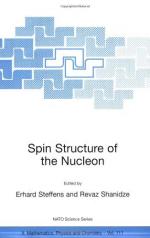|
This section contains 292 words (approx. 1 page at 300 words per page) |
Nucleon is the term used to refer collectively to the particles that are found in the nucleus of an atom, the protons and the neutrons. The proton is a positively charged particle, while the neutron is neutral, but they have similar masses, the neutron being heavier than the proton by only one-thousandth of an atomic mass unit. An attractive force known as the strong nuclear force acts between the nucleons to hold the nucleus together. It acts between two neutrons, between two protons, or between a neutron and a proton, as long as they are no farther apart than a distance of one fermi (10-15 meters).
After developments in modern physics led to a proliferation of subatomic particles, by the 1960s physicists suggested a classification system that would group particles as either fermions or bosons. Fermions are the particles that exhibit half-integer spin and satisfy the Pauli exclusion principle, while bosons exhibit integer spin and are not limited by the exclusion principle. Therefore, nucleons are classified as fermions. A second classification divides particles into those that interact via the strong force, called hadrons, and those that do not, called leptons. Thus, nucleons are classified as hadrons. Hadrons that carry nucleon number one, as do both nucleons, are called baryons. In 1963 Murray Gell-Mann proposed that hadrons are made up of smaller charged particles which he called quarks, with each baryon containing three quarks. The only difference between the two nucleons is the number of each type of quark: protons have two "up" quarks and one "down" quark which give it a charge of +1, while neutrons have two down quarks and one up quark which give it a charge of 0. Gell-Mann was awarded the Nobel Prize in physics in 1969 for this work.
|
This section contains 292 words (approx. 1 page at 300 words per page) |


